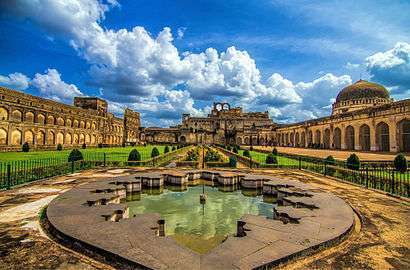Bidar Sultanate
| Bidar Sultanate Barid Shahi dynasty | ||||||||||
| ||||||||||
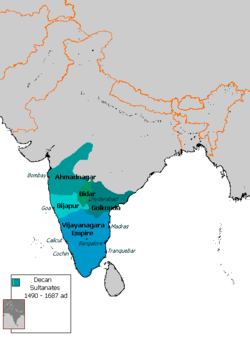 Extent of Bidar Sultanate | ||||||||||
| Capital | Bidar | |||||||||
| Languages | Persian (official)[1] Dakhni Urdu | |||||||||
| Religion | Islam | |||||||||
| Government | Monarchy | |||||||||
| History | ||||||||||
| • | Established | 1489 | ||||||||
| • | Disestablished | 1619 | ||||||||
| Currency | Mohur | |||||||||
| ||||||||||
| Today part of | | |||||||||
Bidar sultanate was one of the Deccan sultanates of late medieval southern India.
History
The sultanate was founded in 1492 by Qasim Barid,[2] who was a Turk from Georgia. He joined the service of the Bahmani sultān Muhammad Shah III. He started his career as a sar-naubat but later became the mir-jumla (prime minister) of the Bahmani sultanate. During the reign of Mahmud Shah Bahmani (r.1482 – 1518), he became the de facto ruler. After his death in 1504, his son Amir Barid became the prime minister and controlled the administration of the Bahmani sultanate. After the death of Mahmud Shah Bahmani in 1518, he was succeeded by four sultans, one after another, but they were mere puppets in the hands of Amir Barid. When the last Bahmani ruler Kalimullah fled to Bidar in 1527, Amir Barid became practically independent. But he never assumed any royal title.
In 1542, he was succeeded by his son Ali Barid, who was the first to assume the title of Shah. Ali Barid joined the other Deccan sultans in the battle of Talikota against the Vijaynagar Empire in January, 1565. After his death in 1580, Ali Barid was succeeded by his son Ibrahim Barid, who after his death in 1587 was succeeded by his younger brother Qasim Barid II. After his death in 1591, he was succeeded by his infant son Ali Barid II, who was soon dethroned by one of his relative, Amir Barid II. In 1601, he was also overthrown by one of his relative, Mirza Ali Barid. In 1609, he was succeeded by the last ruler, Amir Barid III, who fought against the Mughals in 1616 under the leadership of Malik Ambar. In 1619, he was defeated by the Bijapur sultan Ibrahim Adil Shah II. Bidar was annexed to Bijapur sultanate. Amir Barid III and his sons were brought to Bijapur and kept "under surveillance"[3]
Army of the Bidar Sultanate
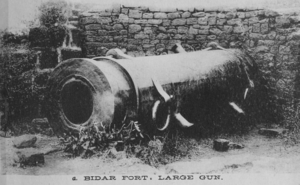
Ali Barid Shah I was an important figure during the Battle of Talikota.
In 1619, Amir Barid III was defeated by the Bijapur sultan Ibrahim Adil Shah II. Bidar was annexed to Mughal sultanate.
Architecture
-

Gateway to Fort of Bidar.
-
Bidar Fort near the entrance.
-
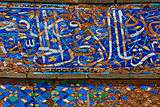
Frescoed calligraphy
-
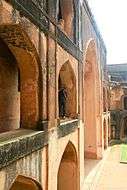
Archways in the fort
-
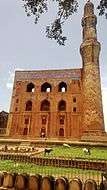
Front view of Bidar Madrasa
-
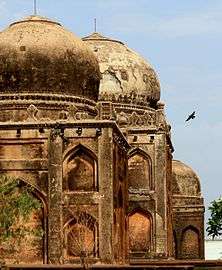
Ashtur Tombs
-

tombs of barid shahi kings at Barid Shahi park Bidar
-

tombs of barid shahi kings at Barid Shahi park Bidar
-

Tombs at Barid Shahi Park Bidar
Rulers
- Qasim Barid I 1489 – 1504
- Amir Barid I 1504 – 1542
- Ali Barid Shah I 1542 – 1580
- Ibrahim Barid Shah 1580 – 1587
- Qasim Barid Shah II 1587 – 1591
- Ali Barid Shah II 1591
- Amir Barid Shah II 1591 – 1601
- Mirza Ali Barid Shah III 1601 – 1609
- Amir Barid Shah III 1609 – 1619
See also
Notes
- ↑ Brian Spooner and William L. Hanaway, Literacy in the Persianate World: Writing and the Social Order, (University of Pennsylvania Press, 2012), 317.
- ↑ Sen, Sailendra (2013). A Textbook of Medieval Indian History. Primus Books. p. 118. ISBN 978-9-38060-734-4.
- ↑ Majumdar, R.C. (ed.) (2007). The Mughul Empire, Mumbai:Bharatiya Vidya Bhavan, ISBN 81-7276-407-1, pp.466–8
.jpg)
